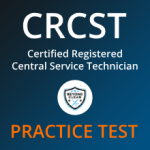In a field where clean and sterile instruments can be the difference between life and death, sterile processing technicians are critical to healthcare.
However, as the industry leans more toward requiring certifications, it raises a key question:
Do you really need a sterile processing technician certificate?
Are the cost and coursework worth it?
While my goal isn’t to steer you in one way or another, I do want to point out the obvious benefits and limited drawbacks of getting a Certified Registered Central Service Technician (CRSCT, the basic level) certification.
To begin with, think about this–if your grandma was having heart surgery, would you want the person cleaning the tools used during the procedure to be certified or not?
What is a Sterile Processing Technician?
In the simplest terms, sterile processing technicians clean, sterilize, assemble, and manage surgical instruments and medical equipment.
They play a vital part in infection control, working behind the scenes in hospitals, surgical centers, and other healthcare facilities.
The job involves meticulous attention to detail, adherence to strict protocols, and a strong understanding of sterilization processes to ensure patient safety during medical procedures.
It can involve a lot of time standing up, wearing personal protective gear, and being exposed to chemicals.
Science and technology are always evolving, suggesting ongoing education is the safest way to excel at work.
The Certification Requirement
In six cases, the certification is required to get the job or keep the job, making it well worth the effort.
Tennessee, Pennsylvania, New York, New Jersey, Connecticut, and Delaware have laws requiring a certification.
Florida, Massachusetts, and Minnesota aren’t far behind.
In these states, no certificate upon entering the field or within a certain length of time from the date of hire means you can’t keep the job.
Beyond that, the remaining 41 states don’t have certification requirements.
While that sounds like a good thing for those looking to cut corners, there’s a key element to remember.
Just because a state doesn’t require it, your hospital or healthcare setting might.
Ways to Earn Your Sterile Processing Technician Certificate
There are many subreddits about whether a sterile processing technician certificate is worth it, and I’ll lean into some information gleaned from there to help here.
The biggest “Aha” moment from workers who have gone through this process slightly alters the question.
Instead of “Is a sterile processing technician certificate worth it?”, it becomes “Is it worth it to go to college or take a course to get a certificate?”
The CRCST has two requirements.
First, you must have 400 hours of hands-on experience in the past five years or the next six months.
Second, you must pass the exam.
Those who pass the exam and don’t obtain 400 hours in the next six months won’t be issued a certificate.
Courses, such as the one offered by Purdue, cost less than $500.
However, if you spend $60 on the Healthcare Sterile Processing Association (HSPA) book, you can study on your own time and take the exam when you’re ready.
Also, many healthcare businesses will hire people who aren’t certified, expecting them to pass the exam within a year.
It’s worth it to consider that path so you’re earning those 400 hours while having time to study and getting workplace support to pass the exam.
Plus, a healthcare entity might be willing to pay for or split the costs of certification training.
In summary, work smarter, not harder, to earn that certificate in sterile processing.
Benefits of Getting Certified
For many, the benefits of certification outweigh the costs.
Certification can significantly enhance job options, as many employers prefer or require certified technicians.
In fact, you’ll notice many listings for “Certified Sterile Processing Technician,” which eliminates any candidate who isn’t certified.
You’ll have a competitive edge in a growing and competitive job market.
Certified technicians also tend to earn higher pay.
With SPT wages ranging from $34,000 a year to $63,950 a year, according to the Bureau of Labor Statistics, the proof is there that more experience and certification means more money.
Certification also opens doors for career advancement.
Some of the more advanced certificates, like becoming a healthcare leader or instrument specialist, will require the CRCST.
Last but certainly not least, being certified and being surrounded by other certified techs means the safest environment possible for patients.
Any healthcare setting that doesn’t put patient safety first might not be the best employer.
Drawbacks and Challenges
Despite the clear benefits, there are some potential speedbumps to keep in mind when considering certification.
First, there’s a potential Catch-22 since you need experience to get certified but can’t get certified without experience.
Beyond the skills of a sterile processing technician, you need the work ethic and personality to sell yourself to a potential employer.
On top of that, you might need to spend more money on a certificate program or college classes to get apprenticeships or externships that help build the hours of experience.
The time commitment for study and exam preparation can also be significant, particularly for individuals juggling work, family, or other responsibilities.
While I’ve read many Reddit responses to this topic, there’s an attitude that this exam is easy.
However, data from 2023 and 2022 shows that about one-third of people fail the test.
Choosing the shortest and least expensive route to certification testing without being able to pass the exam definitely isn’t worth it.
In fact, if you fail the exam and the timeframe to become certified at work has expired, you could lose your job.
For some, the idea of returning to a classroom setting or facing a high-stakes exam can be daunting and may deter them from pursuing certification.
Alternatives to Certification
If certification feels out of reach, there are alternative pathways to gain entry into the field.
Some hospitals and clinics offer on-the-job training for entry-level positions, allowing you to start work as a sterile processing technician and gain experience without initial certification.
While these positions may come with lower pay and fewer advancement opportunities, they provide a valuable foot in the door.
Volunteering, shadowing, or interning at healthcare facilities can also provide exposure to the sterile processing environment.
These experiences can help build connections and lead to job offers, particularly in facilities willing to train and sponsor employees for certification down the line.
As much as healthcare is a competitive industry, there are also a lot of staffing challenges nationwide.
However, that also brings in the potential of loving the experience of being a sterile processing tech while dealing with toxic management or burnout-inducing overtime.
Is Certification Worth It? Key Takeaways
Deciding whether certification is worth it depends on your personal goals, local job market, financial situation, and long-term career plans. Nine times out of 10, certification is the way to go.
- More states are requiring certification for sterile processing technicians.
- Most healthcare employers will require certification at the time of hire or within a designated time, generally one year.
- Certification means more salary potential, better opportunities, and even more advanced certifications to explore.
Consider the demand for certified technicians in your area; if employers in your region prioritize or require certification, it’s a no-brainer.
One final thought–if you choose to be in this demanding field with a fast-paced environment and a lot of stress, why wouldn’t you want to be the most educated and best version of yourself?
Getting certified costs nowhere near what a four-year college degree would, much less medical school.
Yet, you’ll still get to be part of some of the biggest procedures and high-tech surgeries in your community.
Sources
- BLS Salary: https://www.bls.gov/oes/current/oes319093.htm
- Statistics: https://myhspa.org/certification/statistics/
- Requirements: https://myhspa.org/certification/certification-overview/certified-registered-central-service-technician-crcst/
This page is also available in Spanish.










